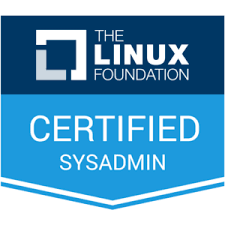LFCS

| Formats: | Asynchronous |
| Blended | |
| Online | |
| Onsite | |
| Part-time | |
| Level: | Beginner |
| Prerequisites: | |
| Recommended Knowledge | |
| Basic familiarity with Linux or Unix-like operating systems. | |
| Introductory experience with command-line operations. | |
Formats: We offer our training content in a flexible format to suit your needs. Contact Us if you wish to know if we can accommodate your unique requirements.
Level: We are happy to customize course content to suit your skill level and learning goals. Contact us for a customized learning path.
Linux Foundation Certified System Administrator (LFCS)
Overview
The Linux Foundation Certified System Administrator (LFCS) certification is a globally recognized, vendor-neutral credential designed for professionals entering the high-demand field of Linux system administration. Offered by the Linux Foundation, this performance-based exam allows candidates to choose between Ubuntu or CentOS, testing their ability to install, configure, manage, and monitor Linux systems. This course covers essential concepts, including Linux design philosophy, subsystem configuration (networking, storage, security), and monitoring/logging practices. With the surge in cloud adoption, LFCS certification equips you with the skills to manage modern Linux infrastructure, making it a powerful boost for your career.
Target Audience
This course is ideal for:
- Beginners aiming to start a career in Linux system administration.
- IT professionals seeking to validate their Linux management skills.
- Administrators preparing for the Linux Foundation Certified System Administrator (LFCS) exam.
- Technicians managing Linux servers in cloud or on-premise environments.
Prerequisites
To succeed in this course, participants should have:
- Basic familiarity with Linux or Unix-like operating systems.
- Introductory experience with command-line operations.
- Access to a Linux environment (Ubuntu or CentOS) for hands-on practice.
What You Will Learn
In this course, you will gain expertise in:
- Installing and managing Linux systems with essential command-line skills.
- Configuring networking, services, and storage for optimal performance.
- Implementing security measures and user management policies.
- Monitoring and automating system operations for reliability and efficiency.
Benefits of the Course
By completing this course, you will:
- Develop practical skills to administer Linux systems in diverse environments.
- Be fully prepared to pass the performance-based LFCS exam on Ubuntu or CentOS.
- Enhance your career prospects in the thriving field of Linux and cloud administration.
- Gain hands-on experience with real-world Linux management tasks.
Course Outline
- Essential Commands
- Log into Local & Remote Graphical and Text Mode Consoles
- Search for Files
- Evaluate and Compare Basic File System Features and Options
- Compare and Manipulate File Content
- Use Input-Output Redirection (e.g., >, >>, |, 2>)
- Analyze Text Using Basic Regular Expressions
- Archive, Backup, Compress, Unpack, and Uncompress Files
- Create, Delete, Copy, and Move Files and Directories
- Create and Manage Hard and Soft Links
- List, Set, and Change Standard File Permissions
- Read and Use System Documentation
- Manage Access to the Root Account
- Operation of Running Systems
- Boot, Reboot, and Shut Down a System Safely
- Boot or Change System into Different Operating Modes
- Install, Configure, and Troubleshoot Bootloaders
- Diagnose and Manage Processes
- Locate and Analyze System Log Files
- Schedule Tasks to Run at a Set Date and Time
- Verify Completion of Scheduled Jobs
- Update Software to Provide Required Functionality and Security
- Verify the Integrity and Availability of Resources
- Verify the Integrity and Availability of Key Processes
- Change Kernel Runtime Parameters, Persistent and Non-Persistent
- Use Scripting to Automate System Maintenance Tasks
- Manage the Startup Process and Services
- List and Identify SELinux/AppArmor File and Process Contexts
- Manage Software
- Identify the Component of a Linux Distribution that a File Belongs To
- User and Group Management
- Create, Delete, and Modify Local User Accounts
- Create, Delete, and Modify Local Groups and Group Memberships
- Manage System-Wide Environment Profiles
- Manage Template User Environment
- Configure User Resource Limits
- Manage User Privileges
- Configure PAM
- Networking
- Configure Networking and Hostname Resolution Statically or Dynamically
- Configure Network Services to Start Automatically at Boot
- Implement Packet Filtering
- Start, Stop, and Check the Status of Network Services
- Statically Route IP Traffic
- Synchronize Time Using Other Network Peers
- Service Configuration
- Configure a Caching DNS Server
- Maintain a DNS Zone
- Configure Email Aliases
- Configure SSH Servers and Clients
- Restrict Access to the HTTP Proxy Server
- Configure an IMAP and IMAPS Service
- Query and Modify the Behavior of System Services at Various Operating Modes
- Configure an HTTP Server
- Configure HTTP Server Log Files
- Configure a Database Server
- Restrict Access to a Web Page
- Manage and Configure Containers
- Manage and Configure Virtual Machines
- Storage Management
- List, Create, Delete, and Modify Physical Storage Partitions
- Manage and Configure LVM Storage
- Create and Configure Encrypted Storage
- Configure Systems to Mount File Systems at or During Boot
- Configure and Manage Swap Space
- Create and Manage RAID Devices
- Configure Systems to Mount File Systems on Demand
- Create, Manage, and Diagnose Advanced File System Permissions
- Setup User and Group Disk Quotas for Filesystems
- Create and Configure File Systems
Please contact us for any queries via phone or our contact form. We will be happy to answer your questions.
Ferndale,
2194 South Africa
Tel: +2711-781 8014 (Johannesburg)
+2721-020-0111 (Cape Town)
ZA
Jumping Bean Contact Form!